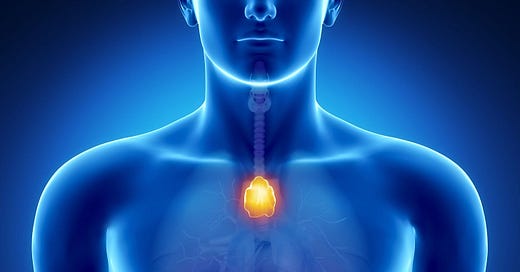Your thymus is one of the leading regulators of aging. Continuous thymic activity well beyond adulthood optimizes the function of the immune system in the context of cancer and infectious diseases.
Your thymus is the source of new T-cell specificities that fight infections, autoimmune cells and cancer. With age, thymus atrophy dramatically reduces the export of new T cells and predisposes an individual to impaired T-cell function, reduced T-cell immunity, and increased autoimmunity. Thymus atrophy is also the primary obstacle to restoration of the T-cell pool in the aftermath of HIV treatment or lymph ablative therapies.
If your thymus gland becomes underactive at any point in your life you may develop a weak immune system and be prone to many infections and allergies. These infections can be chronic and may continue for a long time. When there is a lack of T cells in the body, it can lead to immunodeficiency diseases. Age-related reductions in thymic regenerative capacity as early as young adulthood result in incomplete restoration of T-cell homeostasis after T-cell depletion.
Melissa Ventevogel Senior Research Laboratory Analyst at DHV Institute states:
"The thymus is a vital organ for homeostatic maintenance of the peripheral immune system...the reduced efficacy of the immune system has direct etiological linkages with an increase in diseases including opportunistic infections, autoimmunity, and incidence/burden of cancer. Furthermore the inability of adults to restore immune function following insult induced by chemotherapy, ionizing radiation exposure or therapy, and infections (e.g. HIV-1) leads to increased morbidity and often mortality..."
For aging people, the cascade of events begins with involution of the thymus leading to fewer naïve T cells that leads to resident, peripheral T-cell proliferation. With age these proliferating cells will reach their replicative limit. This is called Hayflick's limit. A normal human cell can replicate and divide forty to sixty times before it cannot divide anymore, and will break down by programmed cell death or apoptosis. The concept of the Hayflick Limit helped scientists study the effects of cellular aging on human populations from embryonic development to death.
While the thymic cellular microenvironment is a 'clock' of the mammalian aging process, thymic involution and diminished T lymphocyte proliferation can be partially restored by thymic tissue transplantation or use of thymic hormones. Thymic regeneration is a powerful approach to rejuvenating a depleted peripheral T-cell pool
With the thymuses they take without consent from babies during heart surgery and from aborted babies they can do thymus transplantation (TT), effective in the treatment of several intractable diseases and conditions, such as autoimmune diseases in aging, advanced malignant tumors, exposure to supralethal irradiation, multiple organ transplantation from different donors, and type 2 diabetes mellitus, for which conventional methods are ineffective.
This article is a primer. I will be delving into diseases associated with thymic involution or damage and the successful treatments given to animals and humans before they were swept under the rug in favor of our current chronic disease model.





standard process makes 2 products that are made from bovine thymus. i’m not going to leave link, but is easily searchable. have you heard of these products and if so do you have opinion on them?
Isn't heart surgery on infants extremely rare, though? What excuse is given for removing the thymus?